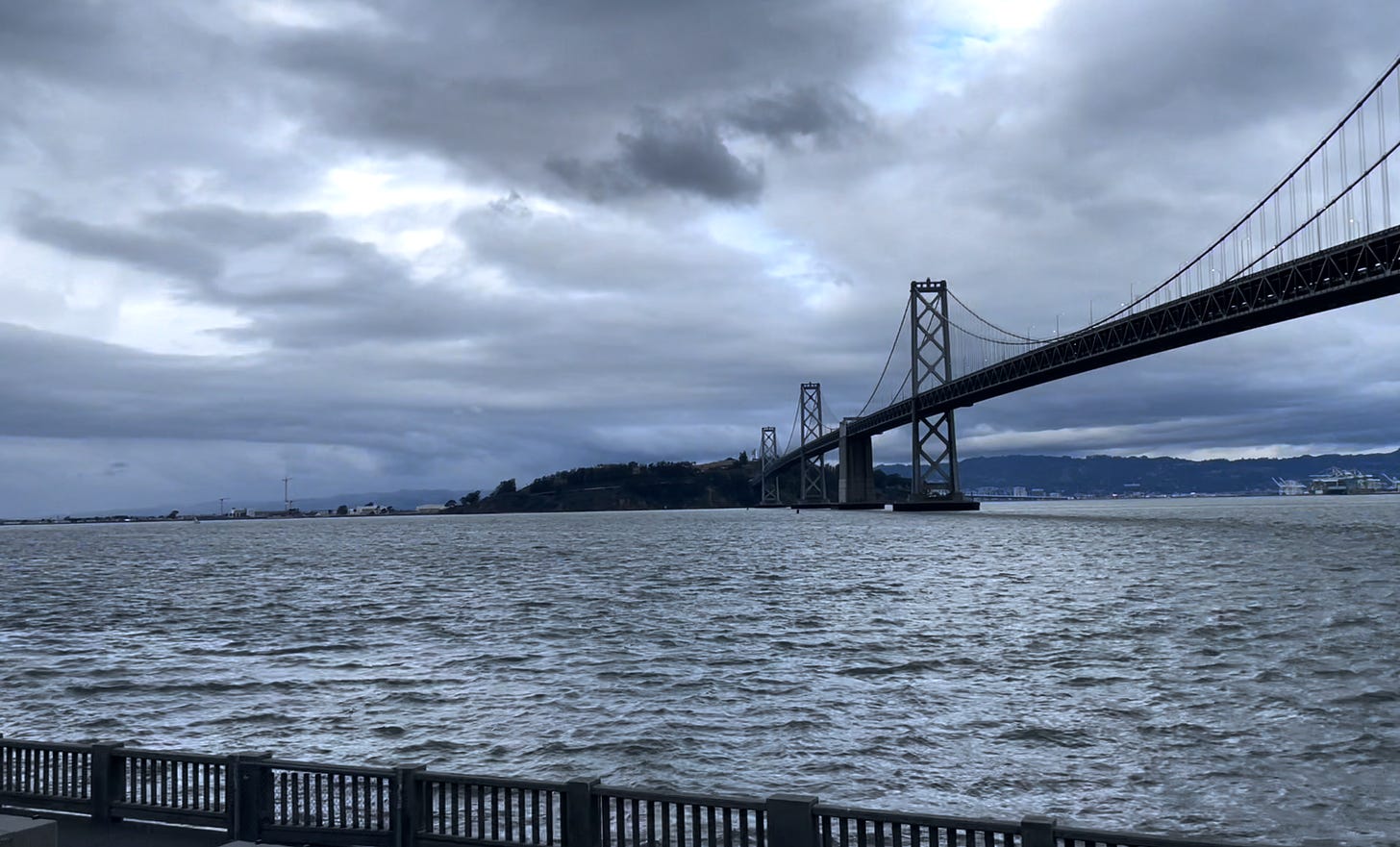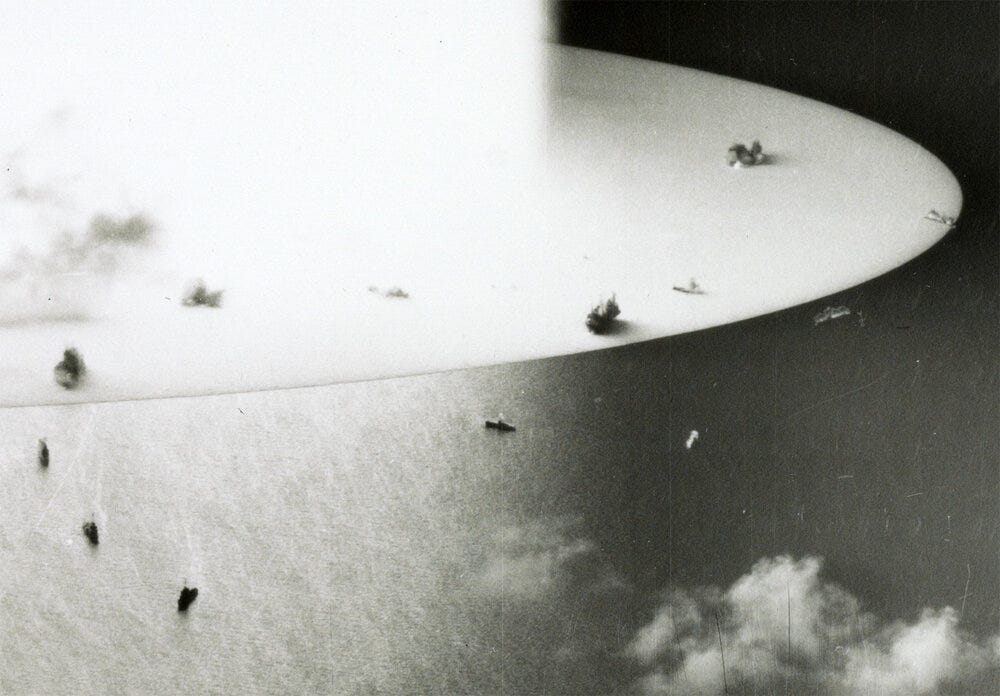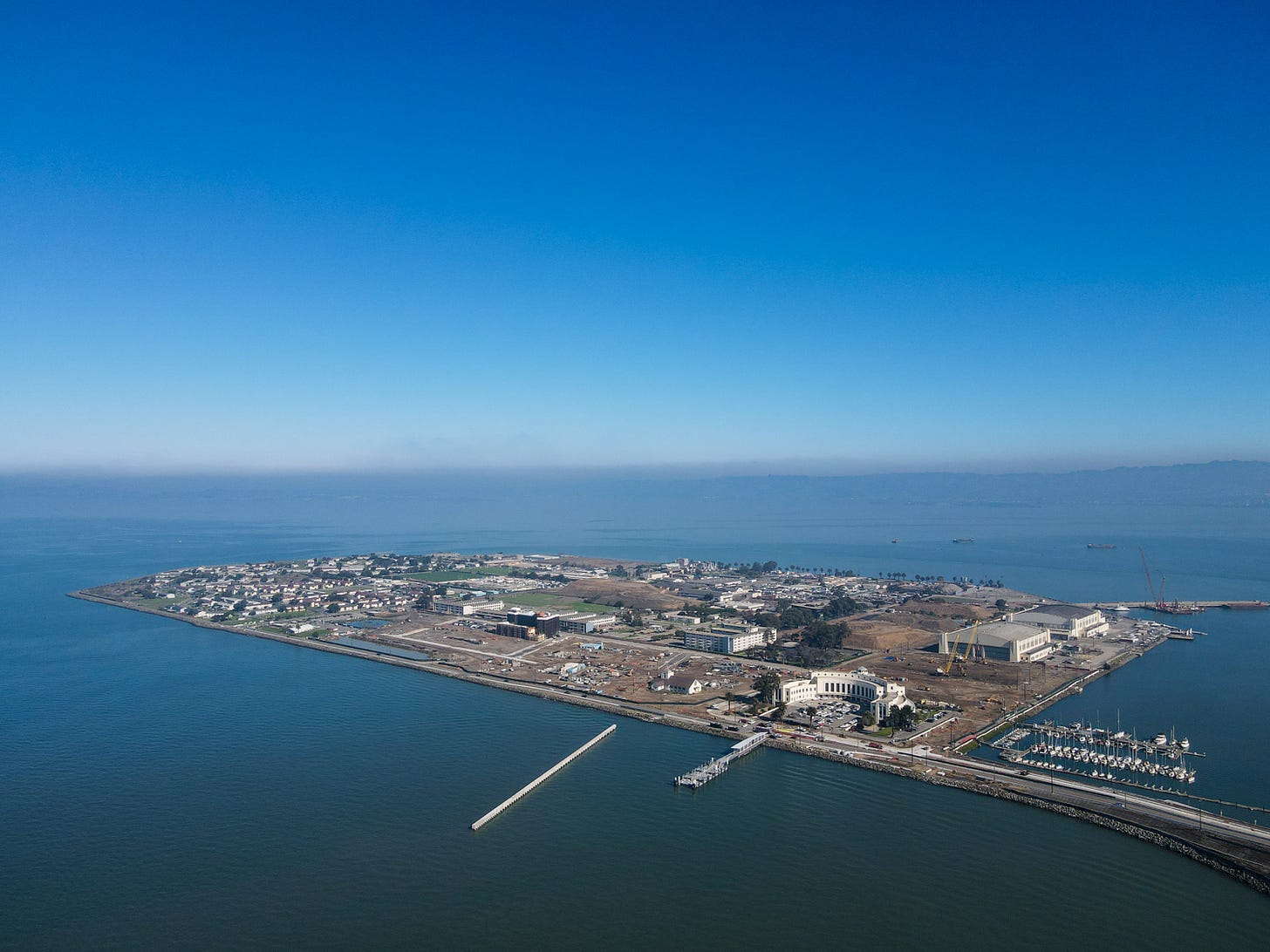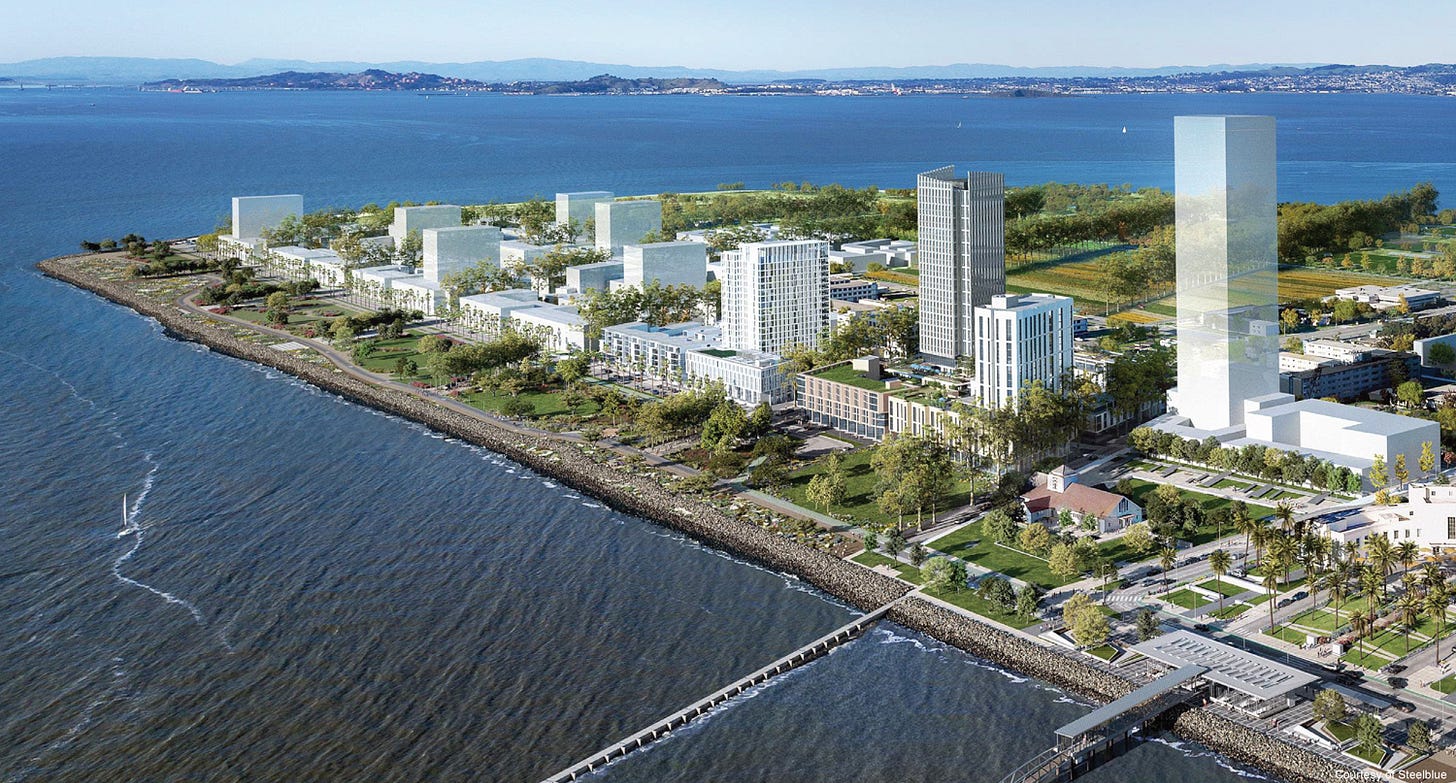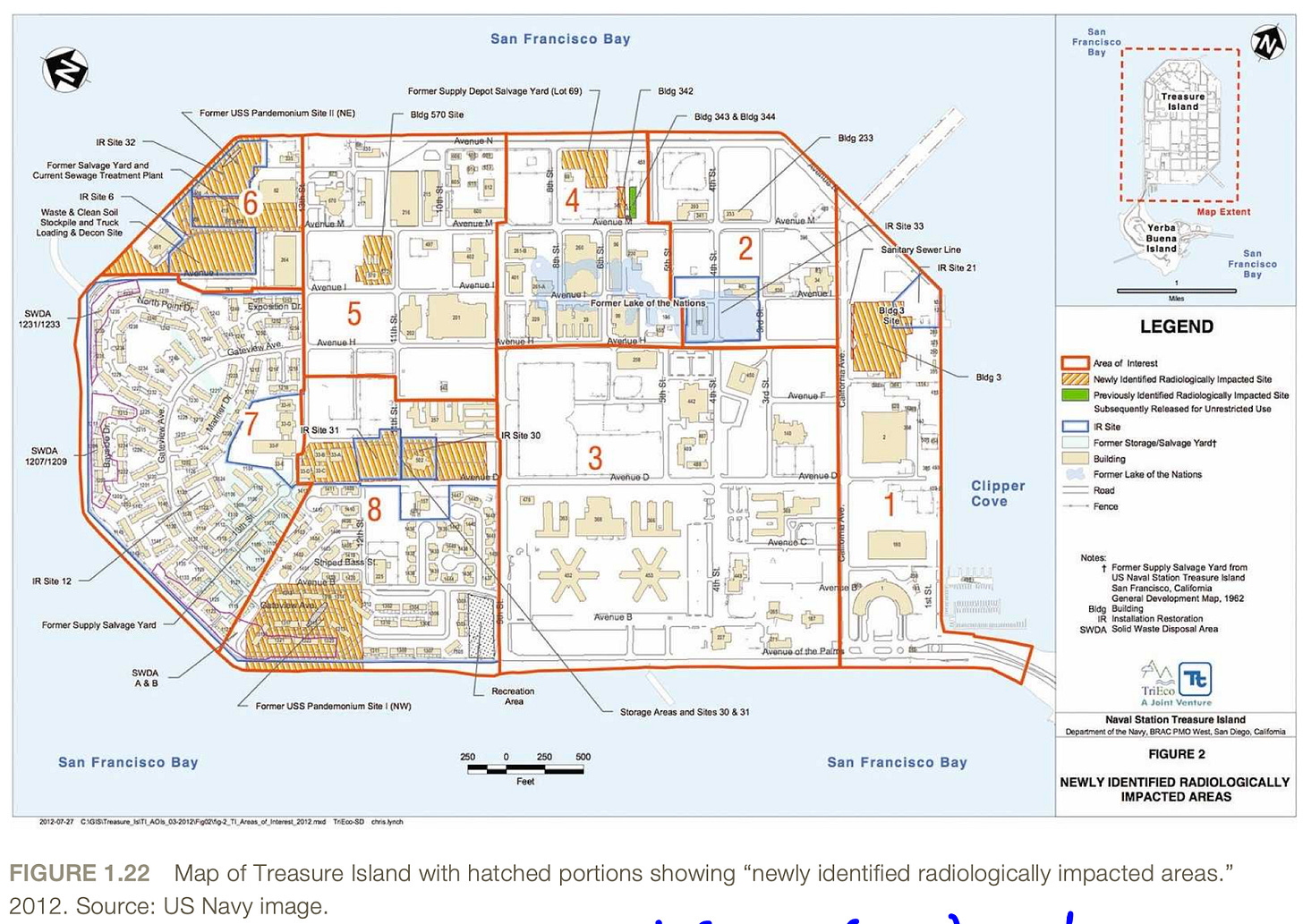Radioactive Living — with grand views of San Francisco!
Welcome to the city's newest multibillion-dollar neighborhood, built on radioactive sand at sea level.
My parents celebrated their 50th wedding anniversary recently. They had a small party at a restaurant almost directly underneath the Bay Bridge. It had a balcony looking east at the water — towards Treasure Island. It was windy that day and every time someone slid open the balcony doors, the room got blasted with an icy gust. I was getting a drink at the bar and, making small talk with the bar tender, I said something like: “Hope the radioactive dust from Treasure Island doesn’t carry this far.” He looked at me, puzzled. Ah, so he didn’t know.
Treasure Island is radioactive — back from the time it was a Naval base, I said. A waitress that was listening in, nodded. Yeah, she heard about that.
If you don’t know San Francisco, Treasure Island is a man-made chunk of land in the Bay a few miles off the coast. It was made by dumping a bunch of rocks and sand on some naturally occurring shoals to build a platform for the Golden Gate International Exposition, a fair held to celebrate the arrival of San Francisco as a world class city back the late 1930s. These days, Treasure Island is in the grips of a high rise development boom — driven by Lennar Corp, one of the largest building companies in the world. Apparently, these clusters of high-rises and condos will solve the housing crisis in the city once and for all. So says the mayor London Breed.

But there’s a small problem. Treasure Island has a toxic history connected to America’s nuclear weapons program. And this history, well, it’s not really history.
After the expo in the 1930s, the island was taken over by the U.S. Navy and used as a staging ground for all sorts of things. Among them: training and small scale experiments with radioactive materials. As a result of this work, the island is littered with radiation, including cesium-137 and radium-226.
Apparently the stuff is scattered all over the island. As one contractor assigned to test the radioactivity of the place said, “We picked up readings from inside the truck, without even getting out of the vehicle. We found radiation, contaminated materials, in playgrounds and in areas that had previously been playgrounds.” Some of the readings they picked up showed that someone hanging out in that area for just one hour would get dosed with more than five times the radiation a worker at a nuclear plant was allowed to get in a full year. The contractor himself had to be taken off the job because he received too much radiation going in the field just to test things. And as journalists discovered, the Navy naturally covered up the full extent of the island’s radioactivity.
As writeup by the Bulletin of the Atomic Scientists explained:
Reporters from The Center for Investigative Reporting pulled proof of the island’s nuclear history from dozens of dusty boxes at the US National Archives in San Bruno, Calif., where visitors are advised to wash their hands before eating in case toxic residue remains in the files. It was uncovered from previously classified files housed at the National Atomic Testing Museum in Las Vegas and the Navy’s own archives. It was coaxed from the memories of those who have lived and worked on the island—and their survivors—and it was even unearthed from the soil on Treasure Island itself.
There are a couple of sources for this nuclear contamination. There was the research and medial training that was carried out on the island using radioactive materials — some of the stuff was spilled, some it had been stored in a very lax way. Then there was bit where the island was used as a waypoint for a few of the ships that had been contaminated with nuclear fallout during Operation Crossroads — the real evil nuclear test op that blew up a couple of bombs at the pristine and beautiful Bikini Atoll to see what happened to ships (and animals placed on them) during a “simulated” nuclear attack, blowing up reefs and dosing the environment, the locals, and everyone who watched the show with massive amounts of radiation. Then there was the fact that the island also hosted a special ship on which soldiers were trained to decontaminate vessels. These “trainings” using real radioactive materials — yeah, right next door to several major cities and a busy bridge that carried thousands and thousands of motorists. The Navy cares about Americans.
Operation Crossroads underwater test. Abstractionism at the gates of hell.
Here’s a great description of these nuclear trainings by Lindsey Dillon, a professor at Santa Cruz, in a collection of essays on Treasure Island’s toxic legacy: “Urban Reinventions.”
A man steps into his white, rubber-lined body suit, zipping it up to his chin. He pulls a protective hood over his head and tightens it against the straps of his gas mask. It is 1968. Flower children gather in San Francisco’s Haight-Ashbury district, and an office-building boom shoots up skyscrapers in the financial district downtown. Across the Bay in Oakland, Huey Newton is convicted of manslaughter and J. Edgar Hoover declares the Black Panther Party “the greatest threat to the internal security of the country.” Thousands of soldiers, headed for Vietnam, pass through the gates of Naval Station Treasure Island, in the middle of the San Francisco Bay, where the man in the white suit fastens his rubber booties and steps out onto the deck of the USS Pandemonium.
A 173-foot mock patrol boat built from salvage and scrap parts, in 1968 the Pandemonium is anchored to the shallow sands of the northwest corner of Treasure Island. Wire cables run throughout the ship, connecting lead-shielded boxes, called pigs, containing radioactive cesium-137 are to a control room on board. A water tank nearby holds a diluted solution of radioactive bromine-82. At the command of the naval instructor in charge of the mock-atomic catastrophe on any particular day, the pigs are opened and 0.65 curies of cesium-137 are pulled up into the fresh air. Soldiers learning how to detect radiation will hunch over their devices and wan- der around the ship, taking measurements of gamma radiation. On other days the instructor might order the bromine solution poured across the length of the deck, spreading into its nooks and crannies.
The rubber-covered officer is enrolled in a six-week course titled Atomic, Biological, and Chemical Defense at the island’s Damage Control School, and today he is learning how to decontaminate a warship. During yesterday’s lecture, the course instructor sets the practice scenario: the ship has just survived a nuclear attack but is covered with the fallout of the bomb. The actual gamma radiation from the Pan- demonium’s cesium sources simulates the fallout. By 1968, decades of experience with nuclear bombs at the Bikini and Enewewok atolls in the Pacific Ocean had revealed, in no uncertain terms, that the threat of nuclear war to naval ships was not simply from the intensity of the bomb’s blast, but the effects of its invisible, lingering radiation. Officers and enlisted men learned how to manage these and other disasters at training centers like the Damage Control School on San Francisco’s Treasure Island.
After the decontamination exercise on the Pandemonium, the student-officer hands his personal dosimeter—a badge containing radiation sensitive film—over to the school’s radiological safety monitor. His daily exposure to radiation will be tallied and recorded in a logbook. The Navy’s manual for running this practice exercise allows him to receive a maximum dose of three hundred millirems of radiation per week, calculated according to National Radiation Safety Committee standards of the time. This threshold value, like the rubber suit, promises to keep him safe from the practice radiation. In 1971, the Pandemonium will be pulled like a parade boat to a new training facility on the northeast corner of the island. Military houses are built on top of the original Atomic, Biological, and Chemical Defense Exercise Area. The housing construction upturns and spreads radioactive radium-226 (which has a half-life of 1,601 years), polychlorinated biphenols, dioxins, arsenic, lead, and other contaminants in the surface soil across the site. When the naval station closes in 1997, civilians seek out homes on the island for the low rents and lovely views.
I used to come out to Treasure Island as a teen to smoke weed, make out with girls, look at the skyline. Thousands of people have lived here since the late 1990s — with children being born, hanging out at playgrounds, digging in yards, growing up to adulthood. A lot of the housing here has been subsidized — meaning the people who have lived have been on the poorer side of our economic pyramid. And they’ve been getting irradiated all this time.
Now, of course, it’s only getting worse. With major developments in the works, construction is booming. From San Francisco, you can see cranes working on the island. Bulldozers are digging, kicking up dust — dust suffused with radioactive particles. The dust’s being sent up for locals and construction workers to breathe. And I presume it’s being carried by the wind to San Francisco, Oakland, Berkeley, and beyond.
Welcome to the newest multibillion-dollar San Francisco neighborhood, built on radioactive sand at sea level. Condos, parks, playgrounds, families, urban density, low-income housing carveouts, dividends, handsome compensation packages — progress! What’s a little radiation when so much is at stake?
I don’t know why I’m drawn to this stuff. I guess I’m just a creature of our toxic industrial civilization. I enjoy digging in the ruins.
—Yasha Levine
Want to know more? Private islands, forgotten California oligarchs, and Jewish converts. Say hello to our ruling class.



